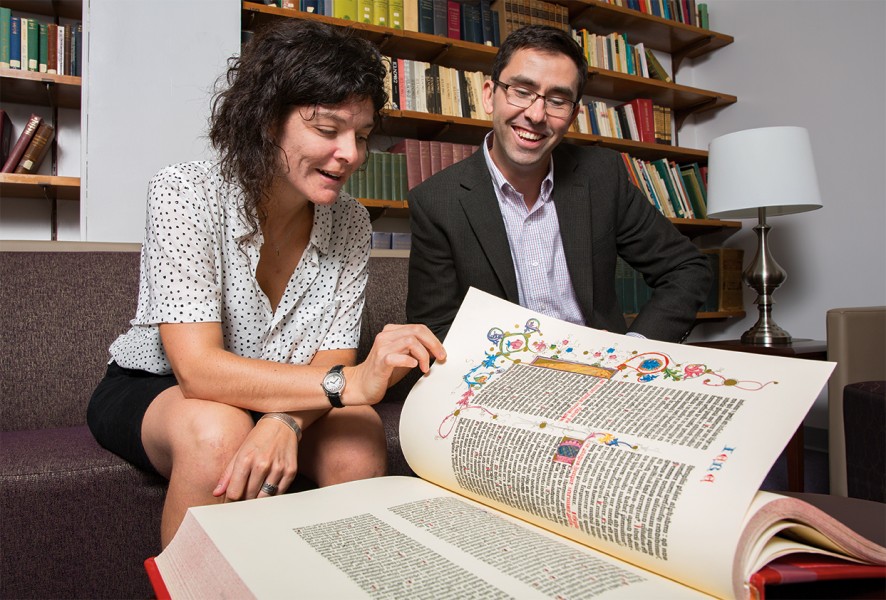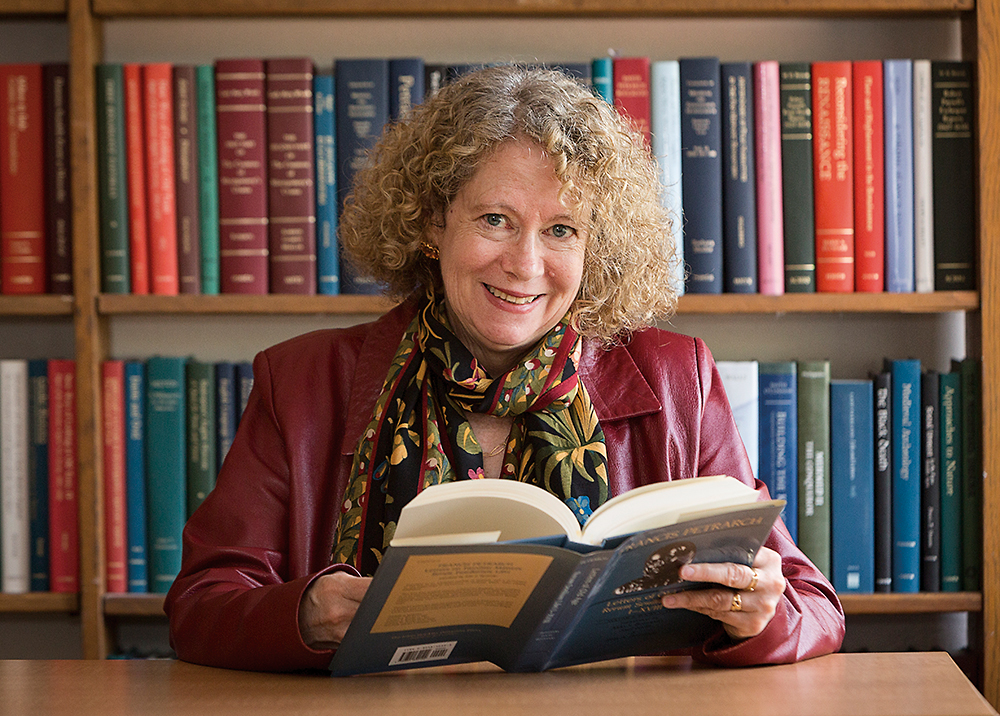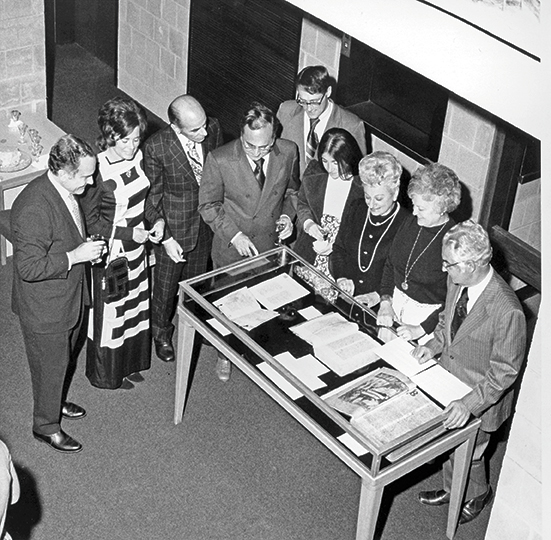CEMERS at 50
Center for Medieval and Renaissance Studies continues to bring scholars together for research, conferences.

For half a century, the Center for Medieval and Renaissance Studies (CEMERS) has been at the forefront of bringing scholars from different disciplines together to promote medieval and early-modern studies.
“The success of the center is a sign of how eager people are to contribute to an interdisciplinary enterprise,” CEMERS Director Marilynn Desmond says. “These activities have contributed substantially to the intellectual culture at Binghamton University.”
As the oldest organized research center at Binghamton University, CEMERS has enabled Harpur College faculty members and students in 14 departments to participate in internationally recognized conferences, lecture series and publications. The center has also helped to raise the University’s profile around the world.
“Everywhere I go, people have heard of Binghamton University because of CEMERS,” says Desmond, a distinguished professor of English who specializes in medieval literature. “I went to a conference in Rome two years ago and a professor from Naples said: ‘Oh, I know Binghamton!’ The humanities at Binghamton have always been identified with CEMERS.”
The Beginning
CEMERS might not have gotten off the ground were it not for the vision of Aldo Bernardo, a founding faculty member of Harpur College who would go on to become distinguished service professor emeritus of Italian and comparative literature.
Bernardo, one of the world’s leading Petrarch scholars, founded CEMERS in 1966 and then invited his colleague Bernard Huppé (a fellow founding professor and medieval scholar in the English Department) to be co-director of the center. At the time, few universities had established centers for medieval studies; by 1966 only UCLA and Western Michigan University had research centers dedicated to the Middle Ages.
“It was extremely ambitious for a new university such as Binghamton to propose a medieval center,” Desmond says.
The initial 1966 proposal stressed that “the activities of the center would fall into two general categories: research, in its broadest sense; and instruction.”
“Most of the permanent staff associated with the center would of course be part of the local faculty,” according to the proposal. “As such, members would contribute to the regular academic programs of the University. In addition, however, special seminars for post-doctoral specialists would be conducted on a regular institute or workshop type of framework or in the form of conferences.”
Bernardo’s idea of a center focused on the exchange between Christianity, Judaism and Islam was ahead of its time, Desmond says.
“From the start, Aldo Bernardo had a vision of doing the kind of intercultural work that is now standard,” she says. “Back in the (1960s and 1970s), it was forward-looking.”
Bernardo and Huppé served as CEMERS directors from 1966-73, as the center built its reputation with conferences addressing topics such as the early Renaissance (1968) and medieval drama (1969). In 1972, CEMERS held the first conference in the world to examine the role of women in the Middle Ages; in 1974, the CEMERS conference looked at Jewish culture in the Middle Ages; and in 1975, Islam and the medieval west.
“Almost nobody else in the 1970s was dealing with Islam and the medieval west,” Desmond says. “Forty years later, such topics are very current.”
The annual conferences attract scholars from all over the United States and the world. One such scholar was John Casteen III from the University of Virginia. He would go on to spend five years as president of the University of Connecticut and 20 years as president of the University of Virginia. He also served as Virginia’s secretary of education from 1982-85.
As a graduate student at the University of Virginia, Casteen attended the first CEMERS conference (“The Meaning of Courtly Love”) in 1967. He also attended the 1977 conference on “The Black Death” and some conferences in the years between. But the inaugural conference was most memorable for Casteen, whose daughter Elizabeth is now an associate professor of history at Binghamton University. (Her research focuses on gender, culture and religion in medieval Europe.)
CEMERS provided “a rich environment for learning and interchange with colleagues,” John Casteen says.
“The first conference in 1967, organized by Frank Newman, has been my personal benchmark for excellence in conferences on various topics that I have organized or attended — none, sad to say, in medieval studies,” he says. “It was crisply organized, challenging in every good way.”
Casteen recalls the impact of “brief interactions” with Bernardo and Huppé during the conference.
“A brief presentation by Bernard Huppé — turned out that day in the most elegant blazer I had ever seen — was dauntingly brilliant, and yet he took time after his session to listen to my dissertation ideas and to suggest new places to look for material,” he says. “. . . I have always remembered Huppé and that day. He understood my issues immediately, tied my half-formed project to others’ work, and noted differences between medieval and modern reading. Standing in a lobby or hallway outside the meeting room, and speaking to visiting graduate students of whom he knew nothing, he listened to us and then, in speaking, dazzled us.”
CEMERS’ impact was felt beyond its conferences and the publications that documented those events. The award-winning, interdisciplinary journal Mediaevalia began publishing in 1975. A grant from the National Endowment for the Humanities paved the way for a medieval studies program in 1977. In 1978, the center launched the Medieval and Renaissance Texts and Studies (MRTS) series. Led by the efforts of Mario Di Cesare, distinguished professor emeritus of English, MRTS published 250 volumes through 1996.
“Bernardo’s plans were grand,” Desmond says. “I don’t think you can say that he managed to bring it all together. But he did start a research center that has an international reputation, still publishes the research it organizes and continues to hold conferences that people from all over the world come to.”
Faculty Strength
Desmond attributes the success of CEMERS to the faculty members who have contributed to the center during the past 50 years.
“The people who ran the conferences weren’t always directors,” she says. “I ran my first conference in 1995 when I was a newly promoted associate professor. Everyone was always welcome to contribute.”
Today, CEMERS has an executive council consisting of nine faculty members and one graduate student. There are 55 faculty fellows associated with the center, including 15 emeriti professors.
But CEMERS also is focusing on new faculty members.
“I believe that the presence of the research center has recently enhanced Binghamton’s ability to recruit talented young scholars . . . who rightly recognize Binghamton’s previous and ongoing strengths in medieval and Renaissance studies and CEMERS as a site of exciting intellectual exchange,” says Olivia Holmes, an associate professor of English and medieval studies who will succeed Dana Stewart as editor of Mediaevalia this fall.
Five tenure-track faculty joined CEMERS in 2015-16, including Jeanette Patterson, an assistant professor of French and medieval studies. CEMERS played a role in Patterson’s decision to apply — and accept a position — at Binghamton University, she says.
“The center has a well-earned reputation nationally within medieval and early modern studies for its leading scholars and high-profile activities, including its journal Mediaevalia, semi-annual conferences and speaker series, and student involvement,” Patterson says. “On a more personal level, I’ve found in CEMERS an incredibly welcoming, supportive, close-knit community of colleagues and mentors under Marilynn Desmond’s leadership. I couldn’t imagine a better environment to grow as a scholar and teacher, and it’s been a real pleasure working with my colleagues in CEMERS so far.”
Desmond says it has been gratifying to lead CEMERS since 2011.
“I’ve tried to create a space where people can work in an interdisciplinary environment to en-hance their own research and develop as research scholars,” she says. “We have developed a sense of ‘research teamwork’ in which we can read each other’s work, support each other and learn from each other in ways that are incredibly beneficial.”
Looking to the Future
CEMERS will celebrate 50 years of research in medieval and early modern studies by hosting a conference on the materiality and visuality of the pre-modern book. “The Pre-Modern Book in a Global Context” will take place Friday and Saturday, Oct. 21-22, at the University Downtown Center.
“There is currently an enormous amount of re-invigoration in the history of the book,” Desmond says. “Digital (technology) is one aspect of it, but there’s also a lot of scientific analysis on books as artifacts.”
The conference will feature four plenary speakers, a plenary panel of library curators, and 80 other presenters from universities in the United States and abroad discussing both the past and future of the book.
“This conference will bring together scholars from a wide range of disciplines who don’t often have the opportunity to work together,” Desmond says. “In medieval and early modern studies, you need expertise in multiple disciplines in order to produce cutting-edge work.”
This fall, CEMERS is publishing a double issue of Mediaevalia on the topic “Medieval Futures.” This special issue includes 12 essays by scholars affiliated with the center in disciplines such as art history, history, English, Italian and French literatures.
Desmond believes that the future of medieval and early-modern research will become more technical and lead to a “new collaboration between science and the humanities.”
An example is the digitization of manuscripts and early printed books — a specialty of new faculty members such as Patterson and Bridget Whearty, an assistant professor of English and medieval studies.
“Technology is changing the kinds of questions we can ask about the past,” Desmond says. “Since the records of the past — from the 8th century to the 16th century — are highly fragmentary, technology can provide new methods for our inquiry.”
The emphasis on digitization brings the CEMERS of today full circle to the CEMERS of 1966, as Bernardo and others had hoped to work locally with IBM to establish cutting-edge ways to store and transmit materials from the pre-modern era.
“They never got it off the ground, but that’s the way they were thinking,” Desmond says. “Now digital humanities is well established. But 50 years ago, Bernardo saw the connection with IBM as something that would benefit the humanities.”
Desmond is aware that the study of the Renaissance and the Middle Ages has started to become a “luxury item” at some universities; she notes that “the inclusion of medieval studies — along with classics — is increasingly a marker of an elite research institution.” In addition, research and teaching on the pre-modern past depend heavily on strong language departments. Harpur College continues to support medieval studies by supporting classics as well as foreign languages.
“The legacy of CEMERS is that we have a proven record of producing high-quality research across the disciplines,” she says. “CEMERS’ international profile contributes immeasurably to Binghamton University’s status as a premier research university.”


